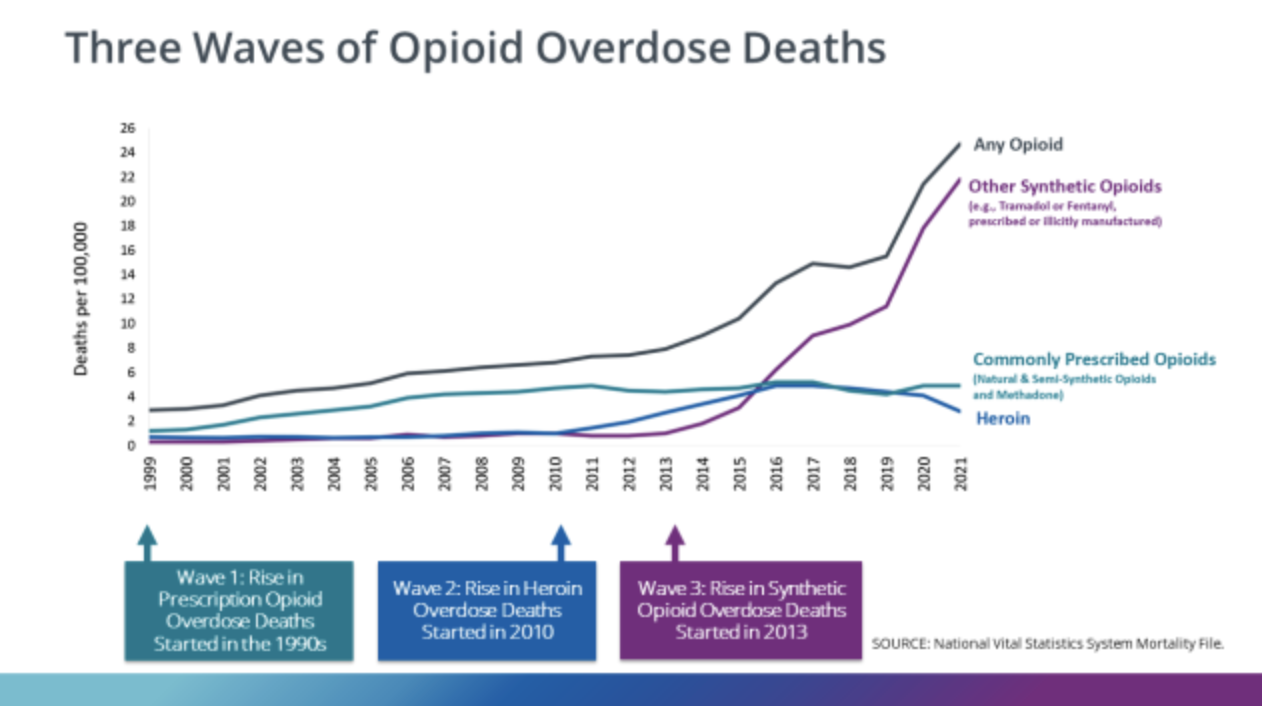Comments
- No comments found

The Centers for Disease Control reports that 645,000 Americans died from opioid overdoses from 1999 -2021.
As the CDC points out, the problem has hit in three waves: a rise in prescription opioid overdose deaths starting in the late 1990s; a rise in heroin overdose deaths starting in 2010; and what appears to be an ongoing sharp rise in overdoses from synthetic opioids like fentanyl starting around 2013.

For an overview of what we know about causes and economic costs, Wenli Li, Raluca Roman, and Nonna Sorokina provide a discussion in “The Economic
Impact of the Opioid Epidemic” (Economic Insights: Federal Reserve Bank of Philadelphia, Third Quarter 2023, pp. 8-14).
Of course, overdose deaths are only one part of the costs of increased opioid use: others include illness, lost worker productivity, higher health care costs, greater likelihood of credit defaults, and others. What caused the increase? As the authors point out, there doesn’t seem to be surge in demand-side factors, so most explanations have focused on changes in supply:
Researchers have concluded that changes in demand-side factors alone—including physical pain, depression, despair, and social isolation—explain only a small fraction of the increase in opioid use and deaths. Moreover, there doesn’t appear to be a substantial link between local economic downturns and rising working-age mortality from drug overdoses, opioids or otherwise. Instead, researchers have identified supply-side factors as the primary explanation for the recent opioid epidemic.
(I should note that one of the citations here is to an article published in the Fall 2021 Journal of Economic Perspectives, where I work as Managing Editor: David Cutler and Edward Glaeser, “When Innovation Goes Wrong: Technological Regress and the Opioid Epidemic.”)
A lot of the policy response to the opioid epidemic has focused on limiting overuse of prescription opioids. Nothing wrong with that as a policy goal. But as the authors point out, making prescription opioids harder to get will tend to encourage people to use illegal opioids instead–which is the source of the bulk of the overdose deaths. Reducing the spread of fentanyl is a very difficult policy problem: it’s relatively easy to make in a high concentrated form. Thus, it can be shipped easily and cheaply–even using regular mail or package delivery. The general idea is that it will be diluted extensively before sale, but quality standards in the illegal drug markets being what they are, some users are likely to end up with unexpectedly heavy doses. Indeed, some users may not even know that what they are using has had fentanyl added.
Studies of state and local laws about opioid use don’t offer much guidance. As the authors note:
Federal, state, and local policymakers have introduced many opioid-related laws and regulations to combat the opioid epidemic. In this article, we focus on state and local laws, as do most previous studies. Broadly speaking, we can divide these regulations into two groups: those that aim to restrict opioid supply and those that aim to restrict opioid demand. However, none of these laws have been very successful at curbing opioid use and abuse.
It is truly remarkable to me how little attention the ongoing opioid crisis seems to get. Around 2015, the annual deaths from opioid overdoses exceeded the deaths from motor vehicle accidents–and has kept rising. Maybe COVID made it impossible for us to consider two public health emergencies at the same time? Maybe when the villain of the piece wasn’t Purdue Pharma and its introduction of oxycontin, but instead became illegal opioids from noncorporate sources, the story no longer attracted the same audience?
Timothy Taylor is an American economist. He is managing editor of the Journal of Economic Perspectives, a quarterly academic journal produced at Macalester College and published by the American Economic Association. Taylor received his Bachelor of Arts degree from Haverford College and a master's degree in economics from Stanford University. At Stanford, he was winner of the award for excellent teaching in a large class (more than 30 students) given by the Associated Students of Stanford University. At Minnesota, he was named a Distinguished Lecturer by the Department of Economics and voted Teacher of the Year by the master's degree students at the Hubert H. Humphrey Institute of Public Affairs. Taylor has been a guest speaker for groups of teachers of high school economics, visiting diplomats from eastern Europe, talk-radio shows, and community groups. From 1989 to 1997, Professor Taylor wrote an economics opinion column for the San Jose Mercury-News. He has published multiple lectures on economics through The Teaching Company. With Rudolph Penner and Isabel Sawhill, he is co-author of Updating America's Social Contract (2000), whose first chapter provided an early radical centrist perspective, "An Agenda for the Radical Middle". Taylor is also the author of The Instant Economist: Everything You Need to Know About How the Economy Works, published by the Penguin Group in 2012. The fourth edition of Taylor's Principles of Economics textbook was published by Textbook Media in 2017.
Leave your comments
Post comment as a guest